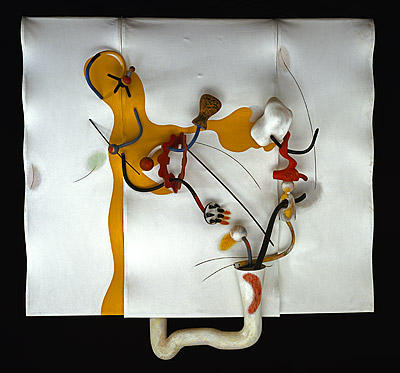Colin
LANCELEY
Aotearoa New Zealand
1938
Australia 1940-65; England, Europe 1965- 81; Australia from 1981
Altar
1967
painted wood, synthetic polymer paint on canvas, synthetic polymer, cotton
inscribed on reverse across stretch polymer paint, l.c., ball point pen, "'ALTAR' Lanceley 1967"
183.0 (h)
x 249.0 (w)
x 33.0 (d)
cm
Purchased 1976
National Gallery of Australia, Canberra
NGA 1976.552
© Colin Lanceley. Licensed by VISCOPY, Australia
Colin Lanceley, Mike Brown and Ross Crothall founded a new group in Sydney in the late 1950s, calling themselves the Annandale Imitation Realists. Influenced by the nascent Pop movement in Britain and the United States, they also looked at ‘outsider art’, exemplified by the French artist Jean Dubuffet’s interest in art made by children and the insane. Using discarded materials and found objects, Lanceley’s first works engineered a clash between art and everyday artefacts. He then made constructions of wooden machine dies and moulds discarded by industry: these were often the negative shapes for casts, weirdly familiar though essentially unrecognisable. In Altar 1967 a number of these forms, vestiges of a tangible reality, are forced into a shotgun marriage with painted shapes on a canvas backdrop. The pliable canvas bulges into a wave-like profile, which reconciles it with the three-dimensional elements.
These objects, despite their machine sources (or perhaps because of them) take on the appearance of alien life forms, flowering luxuriantly in front of yellow and red painted biomorphic forms. It looks as though images by Jean Arp or Max Ernst have come to life to crawl from the canvas into the real world. From the bottom, organic plumbing climbs up to climax in a flaring tuba mouth emitting a bouquet of notes. The triptych format may have prompted the title Altar, but if the painting honours any god it is Bacchus, such is its Monty Pythonesque zest and good-humoured exuberance.
Michael Desmond and Christine Dixon[1]
[1] Adapted by Christine Dixon 2009, from Michael Desmond and Christine Dixon, 1968, National Gallery of Australia, Canberra, 1995, p 69

